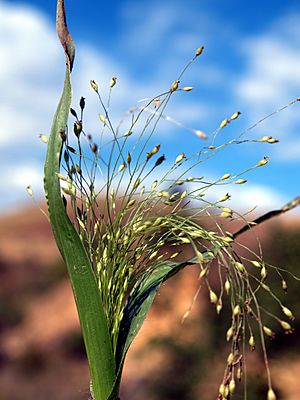Witchgrass facts for kids
Quick facts for kids Witchgrass |
|
|---|---|
 |
|
| Scientific classification | |
| Genus: |
Panicum
|
| Species: |
capillare
|
| Synonyms | |
|
Panicum barbipulvinatum |
|
Witchgrass (scientific name: Panicum capillare) is a type of grass. It grows naturally across most of North America. You can find it from the East Coast all the way to the West Coast. It has also spread to Eurasia, where it grows as an introduced plant. Sometimes, it can be a weed in gardens or parks. Witchgrass can grow in many different places.
Contents
What Does Witchgrass Look Like?
Witchgrass is an annual bunchgrass. This means it lives for only one year. It grows in clumps, like a bunch.
Size and Color
Witchgrass can grow either lying down (decumbent) or standing straight up (erect). It can reach over one meter (about 3 feet) tall. Its color can be green, or sometimes it has hints of blue or purple.
Hairy Parts
This grass is quite hairy. You will especially notice hairs on its leaves. The parts where the leaves join the stem, called nodes, are also very hairy. At the base of each leaf, there is a small flap called a ligule. On witchgrass, this ligule is a fringe of long hairs.
The Flower Head
The plant's flower head is called an inflorescence. For witchgrass, this is a large, open panicle. A panicle is a branched cluster of flowers. This panicle can be very long, sometimes more than half the total length of the plant. It can spread out to be over 20 centimeters wide.
How It Spreads Seeds
When the witchgrass plant dies and dries out, its large panicle can break off. This broken-off part can then roll around in the wind. This is how it becomes a tumbleweed. As it tumbles, it scatters its seeds far and wide.

